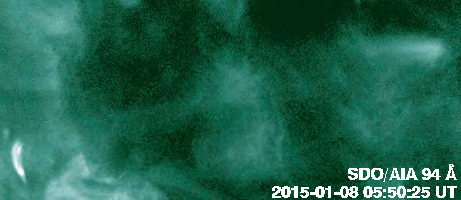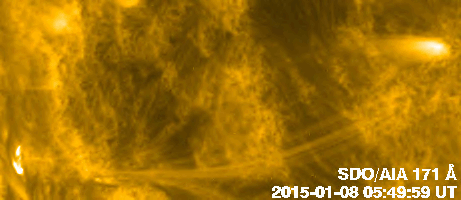 |
 |
 |
 |
Unusual Linear Feature
|
It's not often that XRT sees bright, long, linear structures like the one on the left side of the red image above, just below the center. That's because XRT detects plasma at several million degrees, which is generally confined to the bent, non-potential magnetic field lines energetic enough to do the heating. X-ray jets and emission associated with current sheets are linear features that XRT might detect, but we don't see the bursty flow of a jet in the AIA 94 Å images above (green) and this is probably too thick to be related to a current sheet. The faintness of the feature at 94 Å, and the complete lack of emission in any of the other AIA channels, also tells us that it's at the hotter end of XRT's temperature response, around 10 million Kelvin. Some insight may be gleaned from the potential field source surface (PFSS) model, which extrapolates the coronal potential field based on measurements of the surface magnetic flux. The model predicts a field line (really a bundle of field lines) that's almost perfectly aligned with the XRT feature, highlighted by the thick white line in the upper right image. This field line connects a fan structure, completely invisible to XRT, to a region near the small brightening that occurs in the far left of the AIA/94 movie. Perhaps then, the small flare that produced the brightening also injected enough hot plasma for the line to be seen by XRT, which is a prosaic explanation for this unusual observation. (Also note the beautiful "X" configuration between the two active regions at disk center.) Keywords: Full Disk, AIA, PFSS Filters: Be_thin, AIA/94, AIA/171 |
(Prepared by Patrick McCauley)
| Back | Archive | Next |